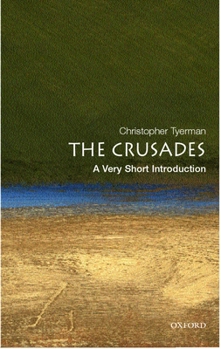The Crusades: A Very Short Introduction
(Part of the Very Short Introductions (#140) Series, Oxford's Very Short Introductions series Series, and Very Short Introductions (#140) Series)
Select Format
Select Condition 
Book Overview
With flair and originality, Christopher Tyerman presents a clear and lively discussion of the Crusades, bringing together issues of colonialism, cultural exchange, economic exploitation, and the relationship between past and present. He considers the effects of the Crusades on ordinary life in Western Europe, and the parts played by ordinary men and women in the conflict, and explores the term "Crusade" for contemporary political ends. Whether the Crusades are regarded as the most romantic of Christian expeditions, or the last of the barbarian invasions, they have fascinated generations ever since, and their legacy of ideas and imagery has resonated through the centuries, inspiring Hollywood movies and great works of literature. In this book, Tyerman skillfully weaves together one of the most extraordinary and vivid episodes in world history.
Format:Paperback
Language:English
ISBN:0192806556
ISBN13:9780192806550
Release Date:January 2006
Publisher:Oxford University Press
Length:192 Pages
Weight:0.37 lbs.
Dimensions:0.5" x 4.4" x 6.9"
Customer Reviews
1 rating
Good information, but dull
Published by Thriftbooks.com User , 16 years ago
I've been impressed with the Very Short Introductions series so far. In general, each little book provides a good overview of the essentials of a given subject in clear, easy to understand style. Christopher Tyerman's introduction to the Crusades certainly covers the essentials--and impressively squeezes them into 144 pages--but it is far from easy to read. I'm not easily daunted by dull books--I own the Domesday Book, for crying out loud--but Tyerman's style in this work was generally very dense, jargon-heavy writing of the kind I was told to avoid in graduate history-writing classes. Simple concepts are obscured in lengthy periodic sentences that have either too many or too few commas (this sounds like nitpicking, but it's actually a jarring problem). The style is of the academic variety that equates opacity with depth. But lest you get the impression that the entire book reads so badly, every once in a while Tyerman drops the jargon and runs several pages with compelling, clear ideas. If you can stand the style and plough on through, you'll find this book very useful. Tyerman does a good job of outlining the development and history of the Crusades, with attention given not only to the Crusader states in the Holy Land, but also to the ideas of Crusading in Spain, southern France, and the Baltic. Along the way, he refutes a lot of modern myths about the crusading movements (the "second sons" theory, colonial theories, and the like) and does a very good job of putting the idea of medieval Christian holy war in its proper historical context. While this introduction is certainly very short, it may prove too daunting for those first approaching the history of the Crusades. For a far more lucid and accessible book, check out Thomas F. Madden's New Concise History of the Crusades. Recommended.







